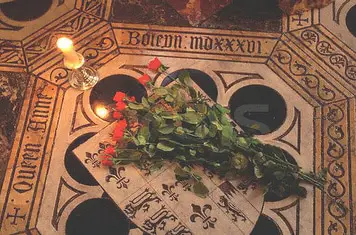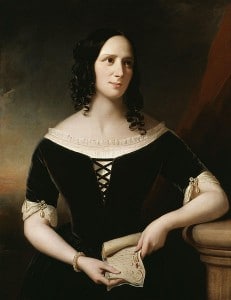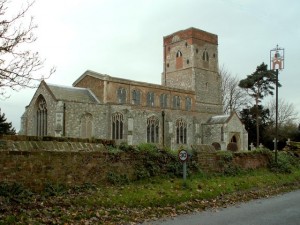I thought I’d write this article as a follow-up to Nancy’s article on “The Ghost of Anne Boleyn” because Nancy mentioned the legend that Anne Boleyn’s body was taken from the Tower and buried at Salle Church, and it’s not the only legend regarding Anne Boleyn’s resting place.

St Peter ad Vincula
The chapel of St Peter ad Vincula, in the grounds of the Tower of London, is the official resting place of Anne Boleyn. After her execution on the 19th May 1536, her ladies wrapped her head and body and placed them in an elm chest which had once contained bow-staves. This chest was then placed in a communal grave, with other execution victims, in the chapel under the chancel pavement. Although Anne Boleyn was a queen, she was given no funeral and no proper burial, she had been executed as a traitor to the Crown and her body was treated as such.
A memorial tile on the floor of the chapel is the only memorial to Anne Boleyn and we don’t even know whereabouts in the chapel her body actually lies. If you have read my article “Anne Boleyn and the Tower of London” you will know that the Victorians dug up a number of skeletons while restoring the chapel in the late 1870s. Although the surgeon, Dr Mouat, identified one skeleton as Anne Boleyn, we can’t be 100% sure that the remains belonged to Anne, so we can only treat that tile as a memorial to her and not as a marker of her grave. Anne could be anywhere under that floor and Alison Weir wonders if Anne was actually buried by the Victorians as Lady Rochford, Anne’s sister-in-law.
Salle Church
There is a very interesting article about Anne Boleyn on the Salle Church website, where they present the “evidence” for the church being Anne Boleyn’s final resting place, although they don’t make any judgement on it. You can read it yourself at http://www.reephambenefice.org.uk/anneboleynsburial.html but the only evidence comes from 19th century sources. Here are the sources quoted by Salle Church:-
1858, ‘Notes and Queries’, written by B. B. Wiffen (page 119)
“It is said in Mrs. Strickland’s ‘Queen’s of England’ (Volume 4, page 203), that there is a tradition in Salle in Norfolk that the remains of Anne Boleyn were removed from the Tower and interred at midnight, with the rites of Christian burial, in Salle Church, and that a plain black stone without any inscription is supposed to indicate the place where she is buried. Sharon Turner, in ‘History of the Reign of King Henry VIII, volume 2, page 264, cites the following passage from Crispin’s account of Anne Boleyn’s execution, written 14 days after her death:
“Her ladies immediately took up her head and the body. They seemed without souls, they were so languid and extremely weak, but fearing that their mistress might be handled unworthily by inhuman men, they forced themselves to do this duty; and though almost dead, at last carried off her dead body wrapt in a white covering”.
The Salle Church website explains that Crispin was a contemporary of Anne Boleyn, a foreign dignitary who was in London at the time of her execution and therefore a primary source. However, although he is cited by Alison Weir in “The Lady in the Tower”, historian John Guy says that Crispin de Miherve is a phantom, he did not exist. Also, although his words state that Anne’s body was wrapped and carried off, he does not say that her body was carried off to Salle.
1842, “Life of Anne Boleyn” (Volume 4), by Agnes Strickland
Victorian author and historical writer, Agnes Strickland, wrote of the Norfolk legend regarding Anne’s resting place:-
“In Anne Boleyn’s native county, Norfolk, a curious tradition has been handed down from father to son for upwards of three centuries, which affirms that her remains were secretly removed from the Tower Church under the cover of darkness, and privately conveyed to Salle Church, the ancient burial place of the Boleyn’s; and there the body was interred at midnight, with the holy rites that were denied to her by her royal husband, at her first unhallowed funeral.”
However, Strickland does point out that it is a legend.

In her 1852, “Lives of the Queens of England” Vol. IV, Strickland mentions Anne’s resting place again:-
“The mysterious sentence with which Thomas Wyatt closes his eloquent memorial of the death of this unfortunate queen, affords a singular confirmation of the local tradition of her removal and re-internment:
“God provided for her corpse sacred burial, even in a place as it were consecrate to innocence” – Thomas Wyatt. “
I’m not sure that Wyatt’s words can be used as evidence to back up the Salle Church legend though seeing as St Peter ad Vincula was and is a chapel and therefore a sacred place and hallowed ground. A communal grave in the chapel may not be the ideal burial place for a Queen of England but it was still a church and therefore “sacred burial”.

1858, “The Queens of England” by Francis Lancelott
On page 398 of his book, Lancelott writes:-
“The remains of the unfortunate Anne Boleyn, covered with a sheet, were placed by her maids in an elm chest and immediately afterwards buried by the side of her fellow victims, in the chapel of the Tower, without singing or prayer; but her friends returned at midnight and disinterred them, and conveyed them away in secret, buried them in Salle Church, in Norfolk.”
I have not read this book and the Salle Church does not give any detail of Lancelott’s sources, so it is hard to pass any judgement on this theory but I wonder if he was basing it on the legend from Strickland’s book.
Charles Dickens
I actually didn’t know that Charles Dickens, one of my favourite authors, wrote about Anne Boleyn. Dickens does in fact write about the story of Anne’s body being taken from the Tower to Salle Church in his 1848 “Bentley’s Miscellany”. However, as Salle Church quite rightly points out, Dickens was writing a fictional account for entertainment, he was not saying it was a true story.
Here is the part about Anne Boleyn:-
“[Anne Boleyn] had apprehended that her remains would be indignantly treated – that the rites of sepulture would be withheld from her, and that her grave would be where no memorial would be found of her; and therefore, her appeal to Wyatt, to save her, if possible, to the tomb of her fathers. Her desire had now, however, a prospect of fulfilment – a grave had been opened in Salle Church, which was the ancient burial place of her father’s family; and thither, on the second night after Wyatt’s arrival, the Earl proceeded, accompanied by his guests, ostensibly for the purpose of having midnight masses said for the repose of his daughter’s soul’ his daughter’s remains, however, went with him. They had, under Mary Wyatt’s care, immediately upon their removal from the Tower to her house, been most carefully embalmed, and wrapped in cere-cloth. In that state, and covered with a black velvet pall, she was placed in one of her father’s carriages, into which Wyatt and his sister entered; the Earl proceeding them in another carriage alone.
What the Earl’s thoughts and reflections were during the two hours he was slowly and unobservedly travelling by Aylsham and Cawston, to Salle, it would not be difficult to divine. He had within a month lost a daughter and a son by the hand of the executioner, – that son his only son, – that daughter the queen of England. Her name, besides, had been branded with infamy; and the prime mover of all this misery to him, – the most active agent to work him all this ill, – to bring his son and his daughter to the block was his own son’s wife, the infamous Lady Rochford. There ended all his dreams and ambitions, – all his influence and prosperity. His children beheaded, – his name dishonoured, – himself shunned. He was now alone, it might be said, in the world. One daughter, indeed, yet remained to him, his daughter Mary; but she had two years before incurred the anger of her father by marrying Sir W. Stafford; and he was, in consequence, utterly estranged from her.
The bitter reflections of those two hours, perhaps the better prepared the Earl for the solemn ceremonies that awaited his coming at Salle Church. He alighted there ad midnight. A few faithful servants bore the mangled remains of his daughter to the side of her tomb; but the perilous duty all there were arranged in would not allow of numerous tapers – of a chappele ardent – of a whole choir of priests, or of grand ceremonials. One priest was there, and the few candles that were lighted did no more than just show the gloom in which they were shrouded.
But all that could be done for the murdered queen was done, – mass was said for the repose of her soul – De profundis (Psalm 130) was chanted by those present, – her remains were carefully lowered into the grave, where they now rest, and a black-marble-slab, without either inscription or initials, alone market the spot which contains all that was mortal of Anne Boleyn – once queen of England.”
Thuse ends the evidence as presented by Salle Church and they are not arguing that Anne Boleyn is buried at the church, they are simply asking “what if” and the legend does appeal to those of us who wish Anne had a more suitable burial place and that she was buried with love and with proper Christian rites.
St Mary’s Church, Erwarton, Suffolk
According to legend, Anne Boleyn and Henry VIII often stayed at Erwarton Hall in Suffolk and Anne loved the place so much that she gave instructions that her heart should be buried in the local church. In 1838, during renovations at St Mary’s church, a heart-shaped casket was found set into an alcove in the north aisle. A plaque at the church explains how this casket was reburied beneath the church organ. Legend has it that Sir Philip Parker of Erwarton Hall, Anne’s uncle,* was the one who buried Anne’s heart there. By the way, the local village pub is named “The Queen’s Head”!

I can’t say that any of these legends make me think that Anne’s body is anywhere but under the floor of St Peter ad Vincula, but I do enjoy a good legend!
Although many people feel that Anne Boleyn’s remains should be exhumed and reinterred in a place more befitting her status as Queen, I personally think that she should left at the Chapel. For one thing, I think it would be nigh impossible to figure our which remains were Anne’s and also I think that the tile on the floor at the Chapel of St Peter ad Vincula speaks volumes about her story – the Queen who was executed on the orders of her husband and buried as a traitor and adulteress. Let that tile tell the story of Anne Boleyn to the many tourists who visit the Tower.
*Anne’s uncle was, in fact, Sir Philip Calthorpe of Erwarton.
Sources
- “Where Was Anne Boleyn Buried?” – an article by Reepham Benefice, the benefice of Salle Church.
- “The Lady in the Tower” by Alison Weir